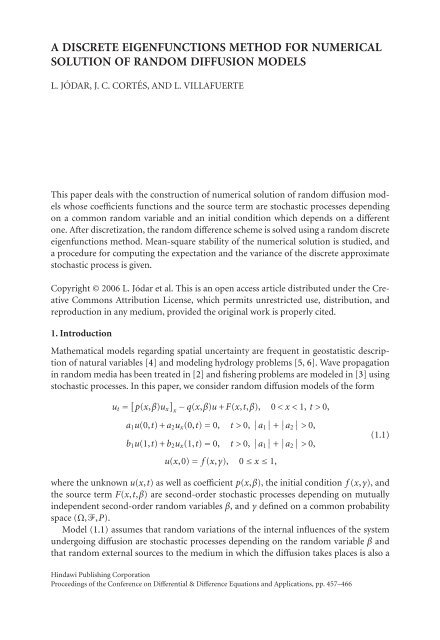DIFFERENtIAl & DIFFERENCE EqUAtIONS ANd APPlICAtIONS
DIFFERENtIAl & DIFFERENCE EqUAtIONS ANd APPlICAtIONS
DIFFERENtIAl & DIFFERENCE EqUAtIONS ANd APPlICAtIONS
Create successful ePaper yourself
Turn your PDF publications into a flip-book with our unique Google optimized e-Paper software.
A DISCRETE EIGENFUNCTIONS METHOD FOR NUMERICAL<br />
SOLUTION OF RANDOM DIFFUSION MODELS<br />
L. JÓDAR, J. C. CORTÉS, AND L. VILLAFUERTE<br />
This paper deals with the construction of numerical solution of random diffusion models<br />
whose coefficients functions and the source term are stochastic processes depending<br />
on a common random variable and an initial condition which depends on a different<br />
one. After discretization, the random difference scheme is solved using a random discrete<br />
eigenfunctions method. Mean-square stability of the numerical solution is studied, and<br />
a procedure for computing the expectation and the variance of the discrete approximate<br />
stochastic process is given.<br />
Copyright © 2006 L. Jódar et al. This is an open access article distributed under the Creative<br />
Commons Attribution License, which permits unrestricted use, distribution, and<br />
reproduction in any medium, provided the original work is properly cited.<br />
1. Introduction<br />
Mathematical models regarding spatial uncertainty are frequent in geostatistic description<br />
of natural variables [4] and modeling hydrology problems [5, 6]. Wave propagation<br />
in random media has been treated in [2] and fishering problems are modeled in [3] using<br />
stochastic processes. In this paper, we consider random diffusion models of the form<br />
u t = [ p(x,β)u x<br />
]x − q(x,β)u + F(x,t,β), 0 0, ∣∣ a 1<br />
∣ ∣ + ∣∣ a 2<br />
∣ ∣ > 0,<br />
b 1 u(1,t)+b 2 u x (1,t) = 0, t>0, ∣∣ a 1<br />
∣ ∣ + ∣∣ a 2<br />
∣ ∣ > 0,<br />
u(x,0)= f (x,γ), 0 ≤ x ≤ 1,<br />
(1.1)<br />
where the unknown u(x,t)aswellascoefficient p(x,β), the initial condition f (x,γ), and<br />
the source term F(x,t,β) are second-order stochastic processes depending on mutually<br />
independent second-order random variables β, andγ defined on a common probability<br />
space (Ω,,P).<br />
Model (1.1) assumes that random variations of the internal influences of the system<br />
undergoing diffusion are stochastic processes depending on the random variable β and<br />
that random external sources to the medium in which the diffusion takes places is also a<br />
Hindawi Publishing Corporation<br />
Proceedings of the Conference on Differential & Difference Equations and Applications, pp. 457–466

















